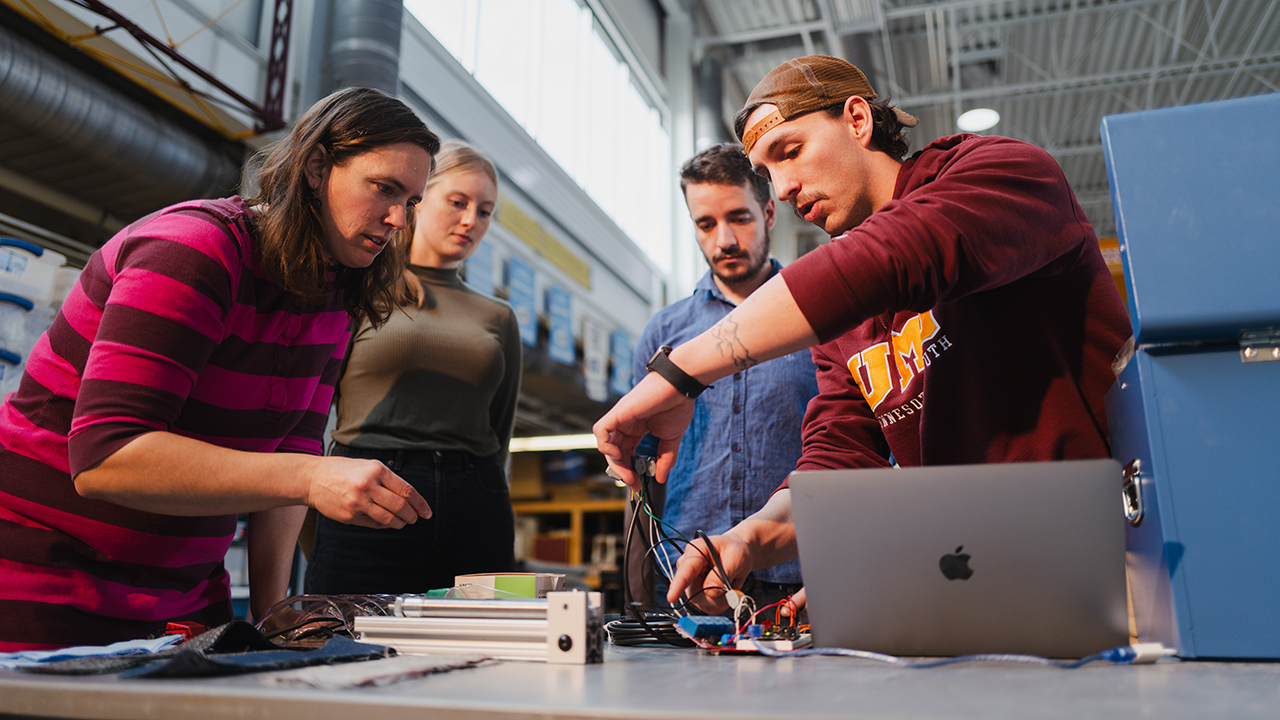
Abbie Clarke-Sather and UMD students Paulo Alves, Stephen Hatt, and Gracie Bahr work around the Fiber Shredder. Credit: University of Minnesota Duluth
Annually, only 15 percent of textile waste is recycled while over 90 million tons of textiles are discarded globally and 14.5 million tons are incinerated or put into landfills in the United States alone. Abbie Clarke-Sather, University of Minnesota Duluth researcher and associate professor of mechanical and industrial engineering, and graduate student Paulo Alves are working on a solution: a machine that they call the Fiber Shredder.
Sustainability Underpins Good Engineering Design
The Fiber Shredder’s origins date back to Clarke-Sather’s time at the University of Delaware, where she held a split position between the Civil and Environmental Engineering and Fashion and Apparel Studies departments. In this role, she first considered the opportunity to apply her engineering background to address sustainability issues in the fashion industry.
“Sustainability is a core principle to apply whenever we're doing engineering,” said Clarke-Sather. “We live on a planet with limited resources, whether they're material or human, and so we've got to make the most we can out of what we have. I think that underpins any good engineering design.”
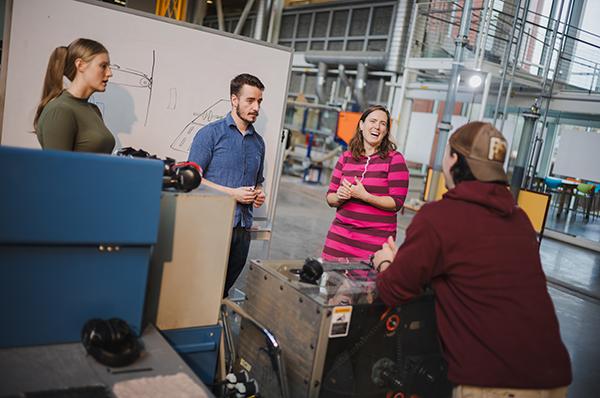
A Goodwill Request Sparks a Research Project
While in Delaware, Clarke-Sather and other fashion faculty were contacted by the local Goodwill, which was shipping discarded apparel overseas to be resold but losing money on the new recycling center they had created due to the labor involved. Goodwill of Delaware CEO Colleen Morrone also wanted to ensure that donations were not wasted, as happened when clothes were improperly distributed, such as snowsuits sent to warmer climates. Goodwill was also interested in finding a way to manufacture new products from discarded apparel in the United States.
When Clarke-Sather moved to Duluth in 2017, she reached out to True North Goodwill for guidance and collaboration opportunities. True North supplied her a bale of discarded apparel which she sorted with students to discover the material content of unsold apparel. Both Goodwills wanted to know what they could do differently to get more value out of this unwanted apparel and to improve sustainability.
“Ever since I talked with Goodwill, it’s been in my mind that I wanted to create a smaller, scalable recycling machine,” said Clarke-Sather. “And I’ve been working on this design for the past six years.”
This work resulted in what she and grad student Paulo Alves call the Fiber Shredder. With a provisional patent, this machine takes existing textiles and shreds them back into fibers in 90 seconds. Unlike similar machines already on the market that cut fibers, the Fiber Shredder pulls fibers apart, which keeps them longer in length and makes it easier to respin them back into yarns that can be used.
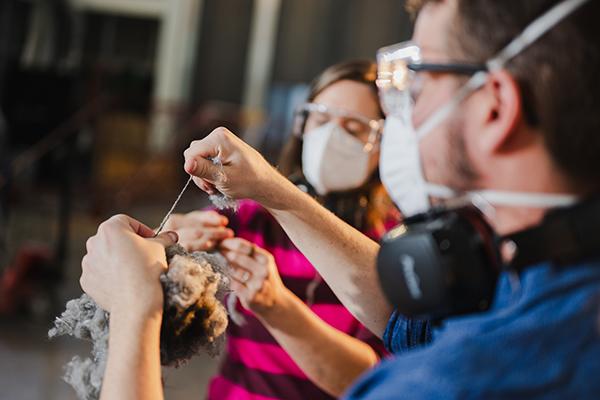
The Fiber Shredder is also unique in that it is versatile enough to handle any textile waste, from cotton and polyester to synthetic blends including elastane (spandex), where existing processes may handle only one type of fabric. Having a machine that can handle a wide variety of materials reduces the amount of sorting needed and makes it easier to quickly process textiles.
The Fiber Shredder Vision
Because the Fiber Shredder is a portable, scalable machine, it can be adopted by a variety of fashion industry partners. Right now the machine can shred a hand towel’s worth of textile in 90 seconds, and Clarke-Sather and her team want to scale it up to be able to shred multiple garments in the same amount of time so it can meet the needs of manufacturers.
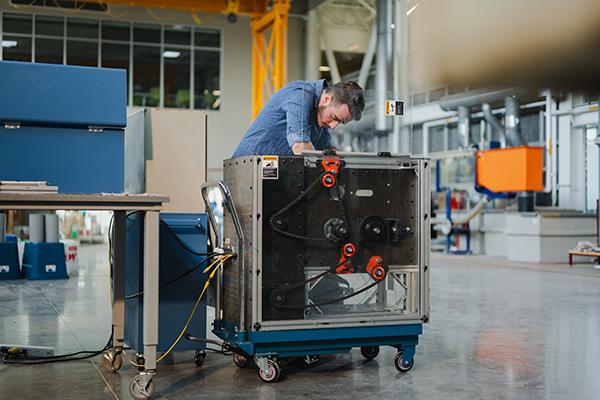
“I think the Fiber Shredder can be a game changer in terms of handling waste in a new way and bringing it back into the value stream and into our hands as new products,” Clarke-Sather said. “It’s really overwhelming what potential we have to make an impact on the climate when we don’t have to produce new fibers to make the textiles we need.”
Clarke-Sather hopes to eventually see the machine in every Goodwill or thrift store across the country. She also envisions it being used by municipalities in their recycling programs and by clothing brands that want to better handle their own waste.
Researcher and Entrepreneur Serving and Working with the Community
Clarke-Sather and Alves have started a small company and are looking for local partners who want to make new products from recycled fibers. Based on this, they’re fine-tuning the machine to work for the people who might use it. They’re also planning to assist with setting up a manufacturing line at True North Goodwill to shred fibers and send to a regional manufacturer to make nonwoven textiles that will be used by local landscaping companies for weed suppression and revegetation.
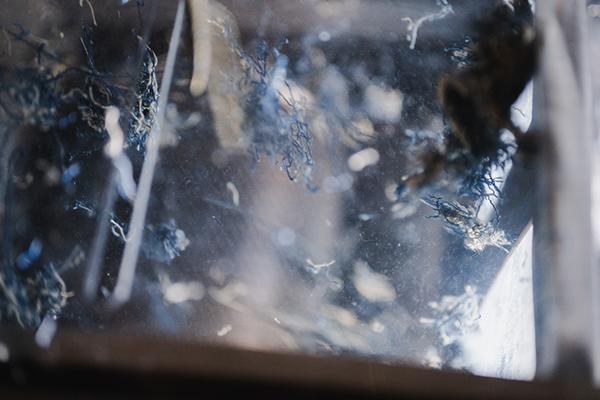
“It’s interesting to be both faculty and an entrepreneur at the same time. It makes me really excited to feel like I’m part of a broad coalition of people trying to make our world more sustainable,” said Clarke-Sather. “I think the freedom that I had at UMD to pursue my passion and applied research really allowed me to make this happen. UMD is a really fun place, where it’s easy to collaborate with folks from other disciplines.”
Clarke-Sather and her team are always looking for more partners, especially people from the community, to reach out with solutions and suggestions of what else they can do with recycled fibers.
“My advice to researchers and students that want to make an impact on the world is to start looking around because there are so many problems. Just pick one and try to figure out a solution. That’s what’s fun about research when it’s applied.”